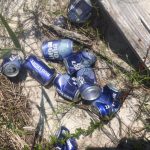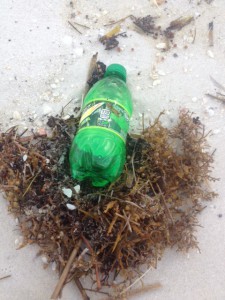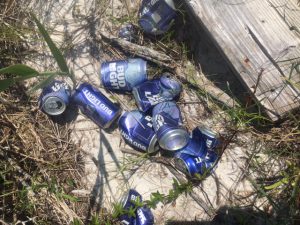
People have been trying to do something about marine debris, and solid waste in general, since we saw the commercial of the crying Indian in the early ‘70’s. Have we made any improvement?

A variety of plastics ends up in the Gulf. Each is a potential problem for marine life. Photo: Rick O’Connor
Yes… but there are still problems to deal with.
Literally millions of tons of solid waste are produced and disposed of each year. According to the 16th edition of Living in the Environment by G. Tyler Miller and Scott Spoolman (2011), Americans generate 2.5 million tons of solid waste each year. This total could fill enough garbage trucks to circle the earth 8 times – bumper to bumper. Though we only make up 4.6% of the world’s population we generate 33% of world’s solid waste. Scientists have been recommending that we reduce the amount of solid waste we produce for some time… but we are not.
So what are we going to do about the problem?
Well, if you are not going to reduce the amount generated you have basically three choices
- Bury it
- Burn it
- Recycle it
Currently Americans are burying about 54% of their solid waste, 25% is recycled, 14% is incinerated, 7% is composted. Comparing our recycling efforts to other nations we are not doing too bad, but there is room for improvement – there is actually a need to improve. The majority of the solid waste we throw away actually ends up in the environment. It has been determined that 80% of the plastics in the ocean come from land – and much of this was thrown in the trash by people who were doing the right thing.
To reduce waste, we need to know what it is we are throwing away. According to Miller and Spoolman the top five items we throw away are:
- Paper/cardboard – 37%
- Yard waste – 12%
- Food – 11%
- Plastics – 11%
- Metal – 8%
Most of these can be recycled or composted – should be easy – but we are not doing it as often as we should.
What about local marine debris?
I have been working with the local group OCEAN HOUR. Ocean Hour cleans a shoreline somewhere in the Escambia / Santa Rosa area every weekend (check out their Facebook page or the Escambia County Extension website to know where). Volunteers come out to help remove the waste and Ocean Hour provides buckets, tongs, and gloves for them to do so. Sea Grant, Escambia County, and students from local schools help to gather data from what they are collecting.
| TOP FIVE ITEMS | 2015 | 2016
|
| 1 | Cigarette butts | Cigarette butts
|
| 2 | Food wrappers | Foam
|
| 3 | Plastic bottles | Plastic bottles
|
| 4 | Plastic pieces | Glass bottles
|
| 5 | Foam | Food wrappers
|
Plastics
There has been a lot of concern about plastics in the environment. Paper, food, and yard waste are oxygen demanding waste, and need to be reduced, but their life span in the ocean is much shorter than plastic. Plastics are made using large polymers produced while refining oil and natural gas. There are about 46 different types and many products are a mix of different polymers. This actually makes some forms difficult, and costly, to recycle. Most counties can recycle #1 and #2 forms of plastic. Water bottles are made from a form of plastic called polyethylene terephthalate (PET). These are easier and less costly to recycle than some other forms but they must be disposed of separately. One PVC bottle in a truck load of plastic water bottles will keep the entire truck load from being recycled.
Another issue, which you will be hearing more about this month, are microplastics. Much of the plastic that reaches the ocean will break down due the sun and the ocean elements. These bring on their own problems – read more about microplastics on this website or the link above.
We certainly encourage all folks who live in the panhandle, or who are visiting, to reduce the amount of solid waste they generate – recycle or compost what you can – and participate in community cleans ups – such as those put on by Ocean Hour. The International Coastal Clean Up will be September 17. Check the Escambia County website for locations. We can do this!
![]()
Posted: September 4, 2016
Category: Natural Resources, Water
Tags: Area, Clean, Coastal, Coming, Debris, Doing, International, Marine, Panhandle Outdoors, September


